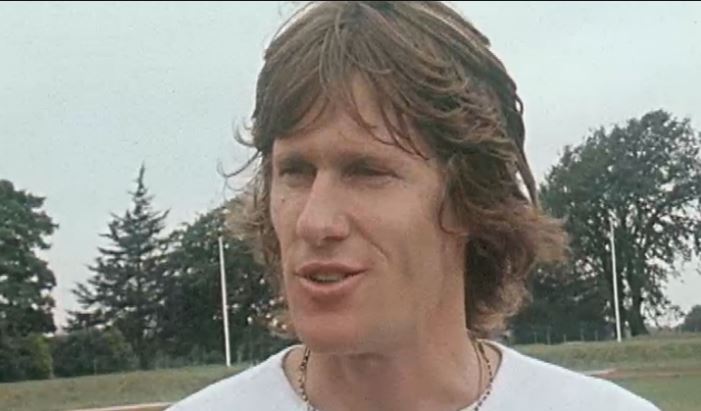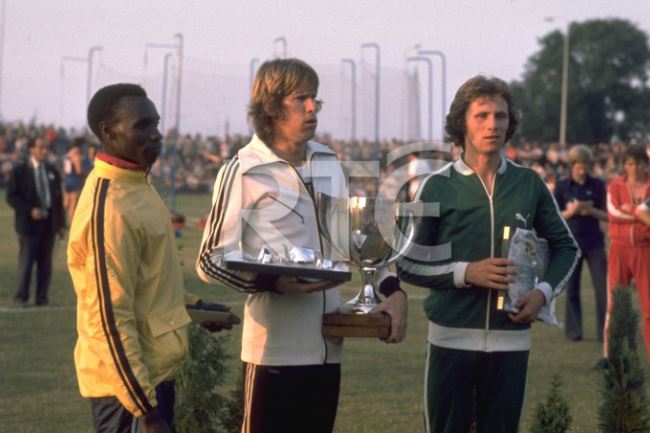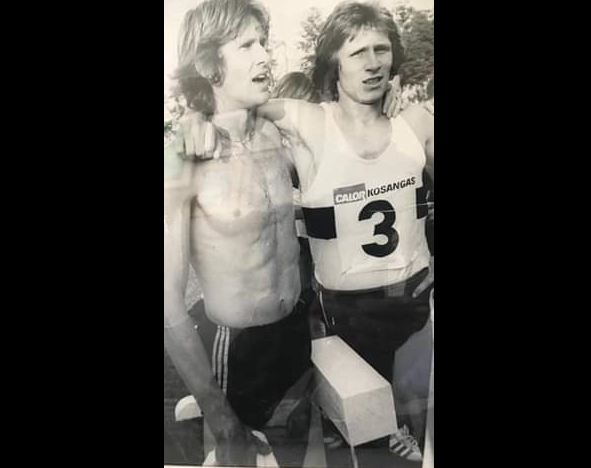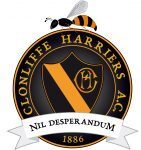Probably the greatest race I’ve ever seen was the Morton Mile of 1977. Billed by the media as a “showdown “ between Ireland’s Eamonn Coghlan and Olympic 1500m. champion , John Walker of New Zealand, it was staged on the brand new tartan track in Belfield. As far as some sections of the Irish press were concerned, it was payback time.
For younger readers, a little background information may be necessary to set the scene. Two years earlier , in 1975, Coghlan had made a big breakthrough by winning both NCAA 1500m titles ( indoors and outdoors ) and then running a 3:53.3 mile In Kingston, Jamaica , when finishing third to Filbert Bayi who set a new world mile record of 3:51.0. Coghlan’s time was a new Irish and European record. Eamonn was getting the reputation of being one of the fastest finishers in the business and few could live with his “stretch drive” as the American pundits called his deadly kick .
Later that same year Walker became the first man in history to break 3:50 for the mile when winning in Gothenburg in 3:49.4. In an interview afterwards, journalists asked him who his main rivals might be for Olympic Gold a year later . “ What about Eamonn Coghlan? “ one guy asked. ”Eamonn who ?” was Walker’s response . Walker , genuinely, had never heard of Coghlan at that stage but some sections of the media chose to interpret this innocent remark as a sarcastic dismissal of Coghlan and his chances.
Coghlan retained his NCAA indoor and outdoor titles in 1976 and, so, the scene was set for the Montreal Olympics. Most of us remember only too well what happened in that 1500 final. Both Walker and Coghlan had dominated their heats and semis ; all the pundits agreed that the Gold lay between them . Eamonn made two mistakes – and young athletes can learn a lot from those errors. First, he shaved his legs the night before the final , something he had never done before. He spent a sleepless night due to the itching in his legs. You NEVER try anything new immediately before an important race ! If you want to experiment, you should only do so before a lesser competition.
His second mistake ( and he himself has freely admitted this several times ) was to listen to too many voices. His Irish coach , Gerry Farman , who had guided Eamonn since he was a boy, told him to sit in as long as possible, keep as much as he could in reserve until coming off the final bend and then unleash his withering kick . ”One big move , and ONE move only “ was the last thing Farnan said to him. But as Eamonn sat brooding in his room the night before , he decided to seek a second opinion. His coach in Villanova , the legendary Jumbo Elliott , advised him to make the pace fast in order to run the sting out of a couple of 800m. runners in the final, Ivo Van Damme ( Belgium) and Rick Wolhuter ( USA ). So , that is the second lesson for young athletes : listen to ONE VOICE and one voice only . If you listen to more than one , you only get confused. Eamonn went into the race in two minds – and that is always fatal . He took the lead after 500m. and then did what ? Precisely nothing! He didn’t slow it down ( as Centro did in Rio) nor did he pick it up . He just meekly pulled the train along at a sedate pace . Walker went past him with 300 to go and the towering figure of Van Damme powered past with 200 left . Eamonn desperately tried to hold onto 3rd. but , right on the line, Paul Wellman of West Germany dipped in front of him. Welllman ! Who had only qualified as a fastest loser – in fact the slowest of the fastest losers . Eamonn has often watched a video of that race since and his reaction never varies : “ I still can’t believe I took the lead at that point “.
That was the background then to the Morton Mile in 1977 which was incorporated into the Donore Harriers International Meet . Rumours circulated that Walker had a bit of a back injury. He was spotted jogging around Belfield the day before and looking somewhat uncomfortable. In an interview with RTE , he said he could only run for 40 minutes before his back went into spasm. In those 40 minutes, he had to warm up , race and cool down . A very narrow window. ! Or mind games , perhaps ?
And so, the scene was set for this “showdown”. July 11 was a balmy evening and a massive crowd packed into the Belfield Bowl. It was a natural amphitheater and thousands of athletic fans took up their positions on the grassy banks surrounding the brand new track which had replaced the old , black bitumen surface which had been there for a few years. Such a massive crowd arrived to watch this shoot out , that hundreds spilled onto the eighth and even the seventh lanes . It might not have satisfied modern health and safety requirements but it created a fantastic atmosphere as the athletes would be running through a tunnel of enthusiastic fans.
The field for the Mile simply oozed class , containing seven Olympians or would be Olympians. In addition to Walker and Coghlan , there was Ken Hall of Australia who had finished 2nd. to Walker in that first sub 3:50 mile. Beside him was Dick Quax who , like Walker, was wearing that intimidating all black NZ strip with the silver fern. Quax had won Silver in the Olympic 5000m. the year before, pushing the legendary Lasse Viren all the way to the line. He had also won Silver in the 1500 at the 1970 Commonwealth Games behind the first of the great Kenyans, Kip Keino . Just six days before this race in Belfield, he had set a new World record of 13:12.9 for the 5K in Stockholm. Quax epitomised the rugged, tough, archetypical Kiwi : he had a remarkable record ,ranging from a 3:56 mile to a 27:41 10000 to a 2:10 marathon. He is generally regarded as one of the toughest runners to have ever come out of that great nursery of distance runners . Alongside him was Wilson Waigwa of Kenya. He was a student at UTEP and a month earlier had won the NCAA 1500 title. He went on to represent his country in the Olympic 5000 in LA. Wearing the blue vest of Scotland was the bearded Frank Clement who ,a year earlier, had finished just a stride behind Coghlan in the Olympic 1500 final . He had also won the World Student Games 1500 In 1973. There was also “ wee” Jim McGuinness from Belfast. He and Paul Lawther formed a powerful Northern Ireland duo in international competitions throughout the 70s. Jim had been selected for the ‘74 Commonwealth Games but had to turn it down as he was concentrating on his Mathematics finals in Queens University. And also lining up was a tall , gangly 20 year old from Longford called Ray Flynn. A student in East Tennessee University, he had just dipped under 4 minutes for the first time a few months earlier . Little did he realise then that he would run 89 sub 4 minute miles before he would retire.
A hush descended on the crowd ; for a moment it seemed as If everybody was holding his breath. And then the gun cracked and the tension was released. There was an immediate chorus of “ C’mon Eamonn” and “ Let’s go , Coghlan”. After the usual jostling, the field settled down and came through the first lap in 59. Pretty sedate for those guys. Hall showed briefly in front before being replaced by Quax . Were the Kiwis running as a team, we wondered. As a 5K runner he needed to use his strength to push it along . Eamonn was on Walker’s shoulder and looking comfortable. This time Eamonn was playing the role of the hunter rather than the hunted.
The pace slowed to 60 and we thought “ it’s not going to be super fast but who cares – it’s shaping up to be a great race with an almighty dust up over the final stages.”. Waigwa took up the running on the cruel , crucial third lap . But again , there was no great injection of pace and they hit the bell in 3:00 flat.
The jangling of the bell increased the almost unbearable tension. The noise of the crowd rose to a crescendo. Walker effortlessly moved to the front . Eamonn glided onto his shoulder . “ This is it” , we thought . “ Eamonn is in exactly the right spot – why hadn’t he done this in Montreal?”. And then ,with 300 to go , it happened. In an eyeblink Walker kicked – or rather he exploded . It was as if he had detonated a turbo charger and in a nano second he was gone . A collective gasp went around the arena; a sort of “oooooo” rippled through the huge crowd . An astonished intake of breath by ten thousand people. And in that moment , we knew it was all over.
A solitary , plaintive voice was heard “Get after him Eamonn”. But even that one voice seemed to lack conviction. And, in fairness , Eamonn did get after him. But you didn’t need to be an expert in differential calculus to recognise the difference between speed and acceleration. It was all too obvious in those fleeting seconds. Some pundits later said that Eamonn ran the last 100m faster than Walker did -and perhaps this was true. But Walker’s ability to change the gears in a twinkling made all the difference. As Walker cruised around the last bend we could only stand and admire this supreme athlete : with his long blonde hair flowing behind him and his physique like that of a Greek god, he truly looked imperious.
And we had to grudgingly admit that this was, indeed, a worthy Olympic Champion . He eased across the line ( young athletes are always taught not to ease off until they have crossed the finish line but when you’re Olympic champion and World Record holder, I guess you can take a few liberties) and stopped the clock at 3:52.76. A last lap of a little over 52 ! Coghlan gave it his all and finished in 3:53.4 – just outside his own Irish and European records. Waigwa came in third in 3:54.5 . Those three times remained the three fastest in the world for that year.
Running the race of his life , Jim McGuinness finished fourth in 3:55.0- a Northern Ireland record which still stands. Ray Flynn came in just 0.3 seconds behind him , taking a full 4 seconds off his PB . Quax came next in 3:56.4 just 0.1 ahead of Clement . Ken Hall finished in 3:57.8 meaning that no fewer than eight men had broken the 4 minute barrier .
Coghlan and Walker jogged around the track , arms aloft and holding hands . They most certainly were rivals but ,in spite of media spin , they were also friends and that friendship has continued to this day . We didn’t know then that Eamonn and coach Farnan had started a new strategy: he was now going to train for the 5000 but would continue to race 1500 and the mile. This was to throw his opponents off the mark . And , of course, it paid rich dividends when he won the World 5000m. title six years later. As we departed into the gathering dusk, we felt a little sad that our hero had been beaten. But , above all , we felt an amazing sense of satisfaction at having seen a world class race and a sense of gratitude at having witnessed in the flesh one of the All-Time Greats of athletics : the world record holder, the first man to break 3:50 , the Olympic Champion – the magnificent John Walker.



